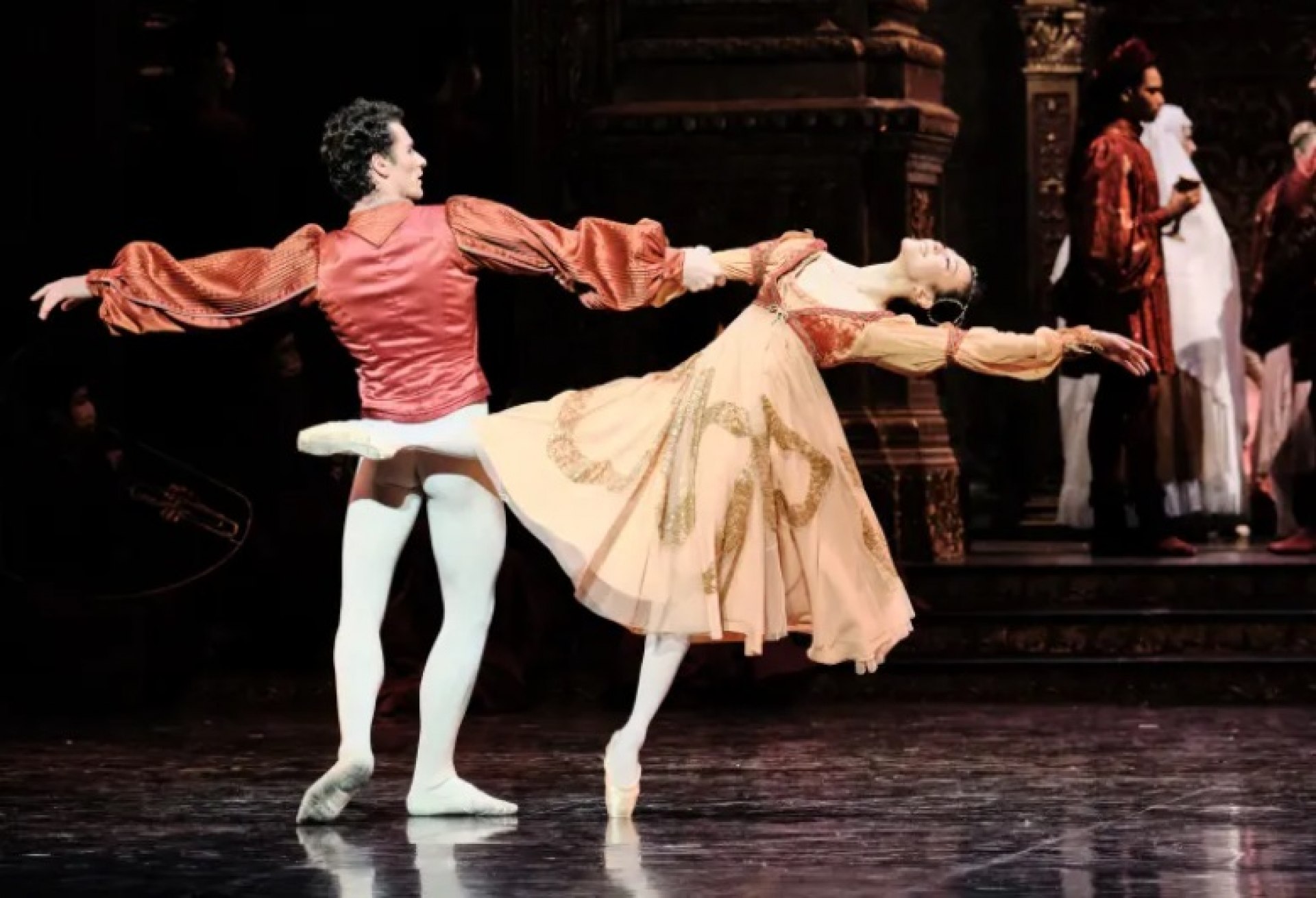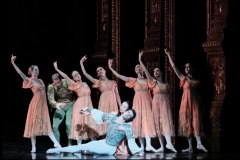Romeo and Juliet
Mo | Tu | We | Th | Fr | Sa | Su |
Ballet
Duration : 3h05 with 2 intervals
Opening:
First part65 minDetails
Intermission20 min
Second part30 minDetails
Intermission20 min
Third part50 minDetails
End
Raised to the status of myth by Shakespeare, the story of Romeo and Juliet had to await the 20th century before being embodied in a ballet thanks to the music of Sergei Prokofiev in 1935.
In his production created for the Paris Opera Ballet in 1984, Rudolf Nureyev transformed this brilliant, energetic score into a sumptuous, particularly cinematic version.
His choreography focuses on the young Romeo's passage into manhood thanks to a passionate Juliet who tragically enters adulthood.
Ball scenes, youthful provocations and duels in a magnificently reconstructed Italian Renaissance lend body, depth and power to the passion of the lovers of Verona at odds with the ancestral hatreds of their families.
CHARACTERS
Romeo: A son of the House of Montague. Initially in love with Rosaline, he becomes enamoured with Juliet at the Capulets’ ball
Juliet: A daughter of the House of Capulet. She is betrothed to Paris but in love with Romeo
Tybalt: Juliet’s cousin. He is killed by Romeo to avenge the death of his friend Mercutio
Mercutio: A friend of Romeo. He is killed by Tybalt
Benvolio: A friend and cousin of Romeo
Rosaline: Romeo’s first love, albeit unrequited
Paris: A young Lord of Verona, in love with Juliet. He dies by Romeo’s hand in Juliet’s tomb
Lord Capulet: The head of the House of Capulet
Lady Capulet: The wife of Lord Capulet
The Nursemaid: Juliet’s confidante
Friar Laurence: A monk and Romeo’s confessor. He secretly marries the two lovers
Synopsis
First part
Scene 1: the market square
The city of Verona is divided by a vendetta between the Montague and Capulet families. Romeo, a young Montague, tries to woo Rosaline, but the young lady remains unmoved. An encounter between the supporters of the rival families degenerates into a brawl. Benvolio tries to pacify his Montague friends, but Tybalt urges on the Capulets. Mercutio, a friend of both families, tries - in vain – to reconcile the two clans. The dispute is interrupted by the arrival of the Prince of Verona, who momentarily restores the peace.
Scene 2: Juliet’s antechamber
Juliet is playing like a child with her friends and her nursemaid. She discovers that her nursemaid likes to be teased (is this what love is?) Her father and mother (Lord and Lady Capulet) enter with their nephew Tybalt. They introduce Juliet to Paris, the young man they have chosen to be her husband. The latter offers Juliet a wedding dress as a gift. Juliet pays scant attention to it.
Scene 3: outside the Capulets’ home
The guests arrive at the party given by the Capulets. Romeo continues to pursue Rosaline but again his advances are rebuffed. Mercutio and his friends make fun of his misfortune by caricaturing the effects of love. Lord Capulet invites Mercutio and his friends inside. They hide their faces behind masks.
Scene 4: the Capulets’ ball
Tybalt leads the dance with Lady Capulet. A hesitant Juliet reluctantly dances with Paris to honour their future betrothal. Romeo, Mercutio and Benvolio join the dance. The inevitable encounter follows. At the first contact of their hands, Romeo (who is still masked) and Juliet fall in love with each other. They exchange a kiss. Romeo is discovered and Tybalt tries to throw him out but Lord Capulet intervenes. All are swept up in the dance of the Wheel of Fate.
Second part
Scene 1: the main square
Romeo dreams of Juliet. The square fills with acrobats, entertainers and the market crowd. Dance of the mandolins (the acrobats) Juliet’s nursemaid suddenly appears: Mercutio and Benvolio tease her. The nursemaid gives Romeo a letter: Juliet has gone to Friar Laurence so that he may secretly marry them. She asks Romeo to join her at the little convent.
Scene 2: a chapel
Romeo is waiting. Juliet arrives and Friar Laurence marries them.
Scene 3: the main square
Once again, the two clans taunt each other. Tybalt tries to provoke Romeo into a duel but the latter refuses, prompting Tybalt to question Romeo’s manhood. Mercutio jokingly responds to Tybalt, but the latter takes his comment seriously. A dagger blade glints and strikes Mercutio. He continues to laugh and scoff at Tybalt despite the fact that he is losing all his blood. Mercutio collapses. The Montagues thrust a sword into Romeo’s hands: in the fight Romeo ends up killing Tybalt. The Prince of Verona arrives with the Capulets. Juliet is horrified to discover that the man she has just married is the murderer of her cousin. Romeo is banished from the city. He is to leave Verona the following morning and seek exile in Mantua.
Third part
Scene 1: Juliet’s bedroom
Whilst Lord and Lady Capulet meet with Paris to discuss his future marriage to Juliet, the latter – in her room – has a premonition: a nightmarish vision of her marrying Death. Romeo enters Juliet’s bedroom from the balcony. The couple are reunited in love. Dawn breaks. Despite her protestations, Romeo extricates himself from Juliet’s arms. Juliet pushes away the wedding dress that her nursemaid and her mother bring her. Lord Capulet compels his daughter to obey him and accept the marriage with Paris. Juliet, in despair, dreams of dying.
Scene 2: A chapel
Juliet hurries to seek the advice of Friar Laurence. But Paris is also there, discussing the details of his marriage. Friar Laurence dismisses Paris and offers Juliet a way out of her awful situation: she must drink a potion that will plunge her into a profound state of unconsciousness. Believing her dead, her parents will place her in the family crypt. In the meantime, Friar John will travel to Mantua to tell Romeo of the plan. Then, during the night, Romeo will come to Verona to find her and, on her awakening, he will take her away. Juliet, filled with new hope, already imagines herself reunited with Romeo.
Scene 3: Juliet’s bedroom
Juliet pretends to agree to the marriage with Paris. Pas de quatre with Lord Capulet, Lady Capulet, Paris and Juliet Left alone, she feels her spirits ebbing and falls prey to doubt: should she take her own life with Tybalt’s dagger and save the family’s honour, or should she swallow the drug to live the love which the image of cheerful Mercutio evokes? Pas de trois with Juliet and the ghosts of Tybalt and Mercutio She drinks the potion.
Scene 4: Juliet’s bedroom
Paris arrives with musicians and dancers to pay his respects to Juliet. The Capulet parents come to wake their daughter but find her lifeless. The wedding preparations give way to mourning. Benvolio rushes to Mantua to inform Romeo.
Scene 5: the road to Mantua
On the road to Mantua, Friar John, who is carrying Friar Laurence’s letter to Romeo, is attacked and killed. The letter which should have alerted Romeo to Juliet’s fake death will never arrive.
Scene 6: Mantua
Romeo dreams of Juliet, unaware of everything that has happened in Verona. He is dragged from his thoughts by Benvolio who brings the news of Juliet’s death. Distraught, Romeo leaves for Verona.
Scene 7: the Capulet’s crypt
Juliet is lying in the Capulet’s crypt. Romeo enters once the mourners have left. He finds Paris and kills him. He then discovers Juliet and, wild with grief, he poisons himself. Juliet opens her eyes, only to find Romeo dead at her side. She kills herself with Romeo’s dagger.
Program and cast
Ballet in three acts After William Shakespeare
Creative team
Rudolf Noureev: Choreography
Sergueï Prokofiev: Music(1891‑1953)
Robert Houssart: Conductor
Ezio Frigerio: Set design and Costume design
Vinicio Cheli: Lighting design
With the Paris Opera Étoiles, Premières Danseuses, Premiers Danseurs and Corps de Ballet
The Paris Opera Orchestra
Warning: getimagesize(/www/htdocs/w010847c/2parisconcerts-tickets/img/80853Untitled.jpg): failed to open stream: No such file or directory in /www/htdocs/w010847c/2parisconcerts-tickets/event.php on line 646
Paris Opera Bastille
RM Europa Ticket GmbH is an officially accredited ticket reseller of/by Opera National de Paris.
Agency number: 4848428
Opéra Bastille
A great modern theatre
The Opéra Bastille is the work of the Canadian-Uruguayan architect Carlos Ott, who was chosen in November 1983 after an international competition that attracted entries from some 1,700 architects. The theatre was inaugurated on July 13th 1989.
Its architecture is marked by transparent façades and by the use of identical materials for both the interiors and the exteriors.
With its 2,700 acoustically consistent seats, its unique stage facilities, its integrated scenery, costume and accessory workshops, as well as its numerous work areas and rehearsal rooms, the Opera Bastille is a great modern theatre.
Stage facilities
Orchestra pit, mobile and adjustable, can be covered; at its largest it can house 130 musicians
Main stage, 45 m high, 30 m wide, 25 m deep, made up of 9 elevators allowing several levels to be created and supported by three main elevators, which bring scenery up from below stage
Clearing zones, 4 storage areas with the same dimensions as the stage
Backstage area, with its scenery turntable
Circulation area, scenery temporarily stored between the stage, workshops and rehearsal stage
Rehearsal stage, the Salle Gounod, with its orchestra pit and dimensions identical to those of the main stage
The building
Area at ground level: 22,000 m²
Floor area: 160,000 m²
Total height: 80 m (including 30 m below street level)
The auditoriums
The main auditorium
Area: 1,200 m², 5% of the total for the building
Dimensions: 20 m high, 32 m deep, 40 m wide
Number of seats: 2,703
Materials: blue granite from Lannelin in Brittany, pearwood from China, glass ceiling
The amphitheatre
Area: 700 m²
Depth : 21.4 m
Number of seats : 450
Materials: white breccia marble from Verona, staff ceiling
The Studio
Area: 280 m²
Depth: 19,5 m
Number of seats: 237
Materials: white breccia marble from Verona and pearwood

 EN
EN DE
DE IT
IT FR
FR ES
ES RU
RU JP
JP RO
RO
 Seating plan
Seating plan 

